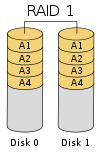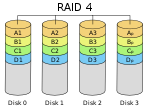http://en.wikipedia.org/wiki/Redundant_array_of_independent_disks
独立冗余磁盘阵列Principles
RAID combines two or more physical hard disks into a single logical unit by using either special hardware or software. Hardware solutions often are designed to present themselves to the attached system as a single hard drive, so that the operating system would be unaware of the technical workings. For example, you might configure a 1TB RAID 5 array using three 500GB hard drives in hardware RAID, the operating system would simply be presented with a "single" 1TB disk. Software solutions are typically implemented in the operating system and would present the RAID drive as a single drive to applications running upon the operating system.
There are three key concepts in RAID: mirroring, the copying of data to more than one disk; striping, the splitting of data across more than one disk; and error correction, where redundant data is stored to allow problems to be detected and possibly fixed (known as fault tolerance). Different RAID levels use one or more of these techniques, depending on the system requirements. RAID's main aim can be either to improve reliability and availability of data, ensuring that important data is available more often than not (e.g. a database of customer orders), or merely to improve the access speed to files (e.g. for a system that delivers video on demand TV programs to many viewers).
The configuration affects reliability and performance in different ways. The problem with using more disks is that it is more likely that one will go wrong, but by using error checking the total system can be made more reliable by being able to survive and repair the failure. Basic mirroring can speed up reading data as a system can read different data from both the disks, but it may be slow for writing if the configuration requires that both disks must confirm that the data is correctly written. Striping is often used for performance, where it allows sequences of data to be read from multiple disks at the same time. Error checking typically will slow the system down as data needs to be read from several places and compared. The design of RAID systems is therefore a compromise and understanding the requirements of a system is important. Modern disk arrays typically provide the facility to select the appropriate RAID configuration.
Standard levels
A number of standard schemes have evolved which are referred to as levels. There were five RAID levels originally conceived, but many more variations have evolved, notably several nested levels and many non-standard levels (mostly proprietary).
Following is a brief summary of the most commonly used RAID levels.[3] Space efficiency is given as amount of storage space available in an array of n disks, in multiples of the capacity of a single drive. For example if an array holds n=5 drives of 250GB and efficiency is n-1 then available space is 4 times 250GB or roughly 1TB.
| Level | Description | Minimum # of disks | Space Efficiency | Image |
|---|---|---|---|---|
| RAID 0 | "Striped set without parity" or "Striping". Provides improved performance and additional storage but no fault tolerance. Any disk failure destroys the array, which becomes more likely with more disks in the array. A single disk failure destroys the entire array because when data is written to a RAID 0 drive, the data is broken into fragments. The number of fragments is dictated by the number of disks in the array. The fragments are written to their respective disks simultaneously on the same sector. This allows smaller sections of the entire chunk of data to be read off the drive in parallel, giving this type of arrangement huge bandwidth. RAID 0 does not implement error checking so any error is unrecoverable. More disks in the array means higher bandwidth, but greater risk of data loss. | 2 | n |  |
| RAID 1 | 'Mirrored set without parity' or 'Mirroring'. Provides fault tolerance from disk errors and failure of all but one of the drives. Increased read performance occurs when using a multi-threaded operating system that supports split seeks, very small performance reduction when writing. Array continues to operate so long as at least one drive is functioning. Using RAID 1 with a separate controller for each disk is sometimes called duplexing. | 2 | 1 |  |
| RAID 2 | Hamming code parity. Disks are synchronised and striped in very small stripes, often in single bytes/words. Hamming codes error correction is calculated across corresponding bits on disks, and is stored on multiple parity disks. | 3 | ||
| RAID 3 | Striped set with dedicated parity or bit interleaved parity or byte level parity. This mechanism provides an improved performance and fault tolerance similar to RAID 5, but with a dedicated parity disk rather than rotated parity stripes. The single parity disk is a bottle-neck for writing since every write requires updating the parity data. One minor benefit is the dedicated parity disk allows the parity drive to fail and operation will continue without parity or performance penalty. | 3 | n-1 |  |
| RAID 4 | Block level parity. Identical to RAID 3, but does block-level striping instead of byte-level striping. In this setup, files can be distributed between multiple disks. Each disk operates independently which allows I/O requests to be performed in parallel, though data transfer speeds can suffer due to the type of parity. The error detection is achieved through dedicated parity and is stored in a separate, single disk unit. | 3 | n-1 |  |
| RAID 5 | Striped set with distributed parity or interleave parity. Distributed parity requires all drives but one to be present to operate; drive failure requires replacement, but the array is not destroyed by a single drive failure. Upon drive failure, any subsequent reads can be calculated from the distributed parity such that the drive failure is masked from the end user. The array will have data loss in the event of a second drive failure and is vulnerable until the data that was on the failed drive is rebuilt onto a replacement drive. A single drive failure in the set will result in reduced performance of the entire set until the failed drive has been replaced and rebuilt. | 3 | n-1 |  |
| RAID 6 | Striped set with dual distributed parity. Provides fault tolerance from two drive failures; array continues to operate with up to two failed drives. This makes larger RAID groups more practical, especially for high availability systems. This becomes increasingly important because large-capacity drives lengthen the time needed to recover from the failure of a single drive. Single parity RAID levels are vulnerable to data loss until the failed drive is rebuilt: the larger the drive, the longer the rebuild will take. Dual parity gives time to rebuild the array without the data being at risk if one drive, but no more, fails before the rebuild is complete. RAID 6 is sometimes referred to as Advanced Data Guarding (ADG). | 4 | n-2 |  |










No comments:
Post a Comment